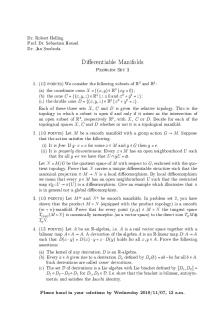Diffgeo 1 blatt 03 PDF

| Title | Diffgeo 1 blatt 03 |
|---|---|
| Author | Влад Самойлов |
| Course | Differentiable Manifolds |
| Institution | Ludwig-Maximilians-Universität München |
| Pages | 1 |
| File Size | 67 KB |
| File Type | |
| Total Downloads | 33 |
| Total Views | 136 |
Summary
Download Diffgeo 1 blatt 03 PDF
Description
Dr. Robert Helling Prof. Dr. Sebastian Hensel Dr. Jan Swoboda
Differentiable Manifolds Problem Set 3 1. (15 points) We consider the following subsets of R2 and R3 : (a) the coordinate cross X = {(x, y) ∈ R2 xy = 0}; (b) the cone C = {(x, y, z) ∈ R3 z ≥ 0 and x2 + y 2 = z}; (c) the double cone D = {(x, y, z) ∈ R3 x2 + y 2 = z }. Each of these three sets X, C and D is given the relative topology. This is the topology in which a subset is open if and only if it arises as the intersection of an open subset of R2 , respectively R3 , with X, C or D. Decide for each of the topological spaces X, C and D whether or not it is a topological manifold. 2. (10 points) Let M be a smooth manifold with a group action G ↷ M. Suppose that the action satisfies the following: (i) It is free: If g ⋅ x = x for some x ∈ M and g ∈ G then g = e. (ii) It is properly discontinuous: Every x ∈ M has an open neighbourhood U such that for all g ≠ e we have that U ∩ gU = ∅. Let N = MG be the quotient space of M with respect to G, endowed with the quotient topology. Prove that N carries a unique differentiable structure such that the canonical projection π∶ M → N is a local diffeomorphism. By local diffeomorphism we mean that every p ∈ M has an open neighbourhood U such that the restricted map πU ∶ U → π(U ) is a diffeomorphism. Give an example which illustrates that π is in general not a global diffeomorphism. 3. (10 points) Let M m and N n be smooth manifolds. In problem set 2, you have shown that the product M × N (equipped with the product topology) is a smooth (m + n)-manifold. Prove that for every point (p, q) ∈ M × N the tangent space T(p,q) (M × N ) is canonically isomorphic (as a vector space) to the direct sum Tp M ⊕ Tq N . 4. (15 points) Let A be an R-algebra, i.e. A is a real vector space together with a bilinear map A × A → A. A derivation of the algebra A is an R-linear map D∶ A → A such that D(x ⋅ y) = D(x) ⋅ y + x ⋅ D(y) holds for all x, y ∈ A. Prove the following assertions: (a) The kernel of any derivation D is an R-algebra. (b) Every a ∈ A gives rise to a derivation Da defined by Da (b) = ab − ba for all b ∈ A. Such derivations are called inner derivations . (c) The set D of derivations is a Lie algebra with Lie bracket defined by [D1 , D2 ] = D1 ○ D2 − D2 ○ D1 for D1 , D2 ∈ D. I.e. show that the bracket is bilinear, antisymmetric and satisfies the Jacobi identity. Please hand in your solutions by Wednesday 2018/11/07, 12 a.m....
Similar Free PDFs

Diffgeo 1 blatt 03
- 1 Pages

Diffgeo 1 blatt 05
- 2 Pages

Diffgeo 1 blatt 07
- 1 Pages

Blatt 03 loesung
- 14 Pages

Blatt 03 - ex3
- 2 Pages

Blatt 03 - WS 2018/2019
- 2 Pages

Blatt 03 - Übung und Lösung
- 5 Pages

Zentralübung Blatt 1
- 1 Pages

Finanzbuchhaltung Übungen Blatt 1
- 10 Pages

Blatt 1 - Ilias SoSe19
- 3 Pages

Blatt 1 - Statistik Aufgaben
- 3 Pages

Blatt 4
- 2 Pages

Blatt 06
- 2 Pages

Blatt 01
- 3 Pages

DGL 1 Blatt 2 Präsenzaufgaben
- 7 Pages

Blatt 01
- 2 Pages
Popular Institutions
- Tinajero National High School - Annex
- Politeknik Caltex Riau
- Yokohama City University
- SGT University
- University of Al-Qadisiyah
- Divine Word College of Vigan
- Techniek College Rotterdam
- Universidade de Santiago
- Universiti Teknologi MARA Cawangan Johor Kampus Pasir Gudang
- Poltekkes Kemenkes Yogyakarta
- Baguio City National High School
- Colegio san marcos
- preparatoria uno
- Centro de Bachillerato Tecnológico Industrial y de Servicios No. 107
- Dalian Maritime University
- Quang Trung Secondary School
- Colegio Tecnológico en Informática
- Corporación Regional de Educación Superior
- Grupo CEDVA
- Dar Al Uloom University
- Centro de Estudios Preuniversitarios de la Universidad Nacional de Ingeniería
- 上智大学
- Aakash International School, Nuna Majara
- San Felipe Neri Catholic School
- Kang Chiao International School - New Taipei City
- Misamis Occidental National High School
- Institución Educativa Escuela Normal Juan Ladrilleros
- Kolehiyo ng Pantukan
- Batanes State College
- Instituto Continental
- Sekolah Menengah Kejuruan Kesehatan Kaltara (Tarakan)
- Colegio de La Inmaculada Concepcion - Cebu